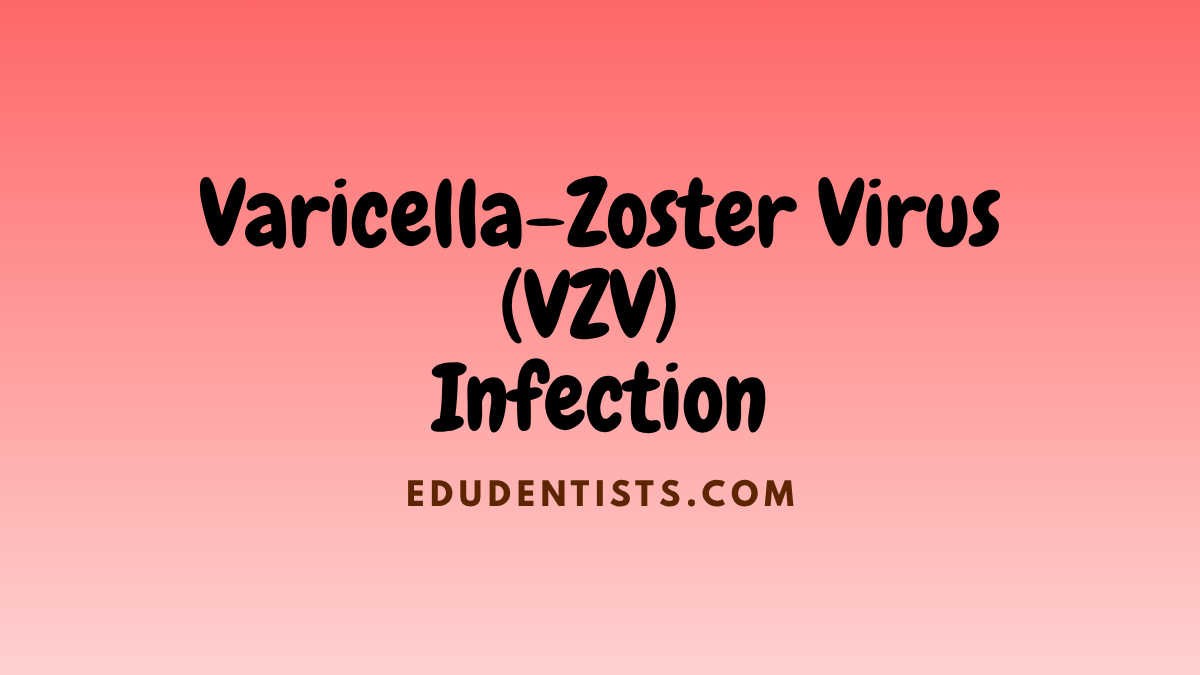
Varicella-Zoster Virus (VZV) Infection
Varicella-Zoster Virus (VZV) Infection: Etiology, Clinical Features, and Oral Implications
Etiology and Pathogenesis
Varicella-zoster virus (VZV), a member of the α-herpesvirus group, is responsible for two distinct clinical conditions: varicella (chickenpox) as the primary infection and herpes zoster (shingles) as the reactivation disease. Following primary infection, the virus becomes latent in the dorsal root or cranial nerve ganglia. Reactivation, more common in the elderly and immunocompromised patients, results in herpes zoster infection (HZI), characterized by unilateral vesicular eruptions in a dermatomal pattern. VZV is transmitted primarily via respiratory droplets, with an incubation period of 2–3 weeks.
Clinical Features
Primary VZV infection typically occurs in children and presents with a low-grade fever, malaise, and an intensely pruritic maculopapular rash that progresses to vesicles and scabs. The rash typically starts on the face and trunk, spreading centrifugally. Complications can include encephalitis, pneumonia, myocarditis, and hepatitis, particularly in immunocompromised hosts.
Herpes zoster presents in adults as a prodrome of deep, burning pain, followed within days by clusters of vesicles in a unilateral dermatomal distribution. Commonly affected dermatomes include thoracic/lumbar and craniofacial regions. Lesions resolve in 2–4 weeks but may leave scars and hypopigmentation. Atypical presentations, including zoster without rash (zoster sine herpete), can occur and may cause diagnostic confusion. A major complication is postherpetic neuralgia (PHN), persistent neuropathic pain lasting months to years after the acute phase, especially in patients over 50.
In immunocompromised patients, HZI may involve multiple dermatomes, have a prolonged course, and result in severe complications such as encephalitis, pneumonitis, and anterior horn cell involvement, which can cause paralysis.
Oral Manifestations
In primary varicella, oral ulcers may appear but are generally overshadowed by skin lesions. In herpes zoster, oral lesions follow the dermatome of the trigeminal nerve branches.
- Involvement of the ophthalmic (V1) division may cause herpes zoster ophthalmicus, which can threaten vision.
- The maxillary (V2) branch leads to unilateral painful ulcers on the hard palate and buccal gingiva.
- Mandibular (V3) involvement can result in ulcers on the tongue and mandibular gingiva.
Lesions present as 1–5 mm painful ulcers, often coalescing, and healing occurs within 10–14 days. - Oral post herpetic neuralgia is rare. Ramsay Hunt syndrome, a complication involving the geniculate ganglion, presents with facial palsy, ear vesicles, and loss of taste.
VZV has also been associated with osteonecrosis and spontaneous exfoliation of teeth, especially in patients with HIV.
Differential Diagnosis
HZI may be misdiagnosed as dental conditions such as pulpitis due to prodromal pain, or HSV infection due to similar vesiculoulcerative lesions. Other differentials include autoimmune blistering diseases (pemphigus, pemphigoid), necrotizing ulcerative periodontitis (NUP) (particularly in HIV patients), and medication- or radiation-induced osteonecrosis. Coinfection with CMV should also be considered in immunosuppressed individuals.
Laboratory Diagnosis
Diagnosis is usually clinical. For confirmation, VZV can be isolated via viral culture, though it is difficult to grow. Cytology may reveal multinucleated giant cells but cannot distinguish VZV from HSV. Direct fluorescent antibody testing and PCR offer higher sensitivity and specificity, though they detect viral antigen rather than active infection. Serology may show IgG after infection and a transient IgM rise during reactivation, but these are not reliable for diagnosis. Biopsy is rarely needed but may show cytopathic epithelial changes similar to HSV.
Management
Management focuses on symptomatic relief, prevention of complications (especially postherpetic neuralgia), and antiviral therapy.
- For primary VZV, acyclovir (800 mg five times daily) can reduce lesion severity and complications.
- For HZI, valacyclovir (1000 mg three times daily) or famciclovir (500 mg three times daily) started within 72 hours of rash onset significantly reduces symptoms and the risk of PHN.
- Pain management includes gabapentin, lidocaine patches, and topical capsaicin, with opioids and tricyclic antidepressants reserved for refractory cases. Corticosteroids have not shown benefit in preventing PHN.
Prevention
A live-attenuated VZV vaccine has been shown to reduce the incidence of varicella outbreaks. Vaccination of older adults boosts antibody levels, enhances cell-specific immunity, and reduces the severity and frequency of subsequent HZI and postherpetic neuralgia.